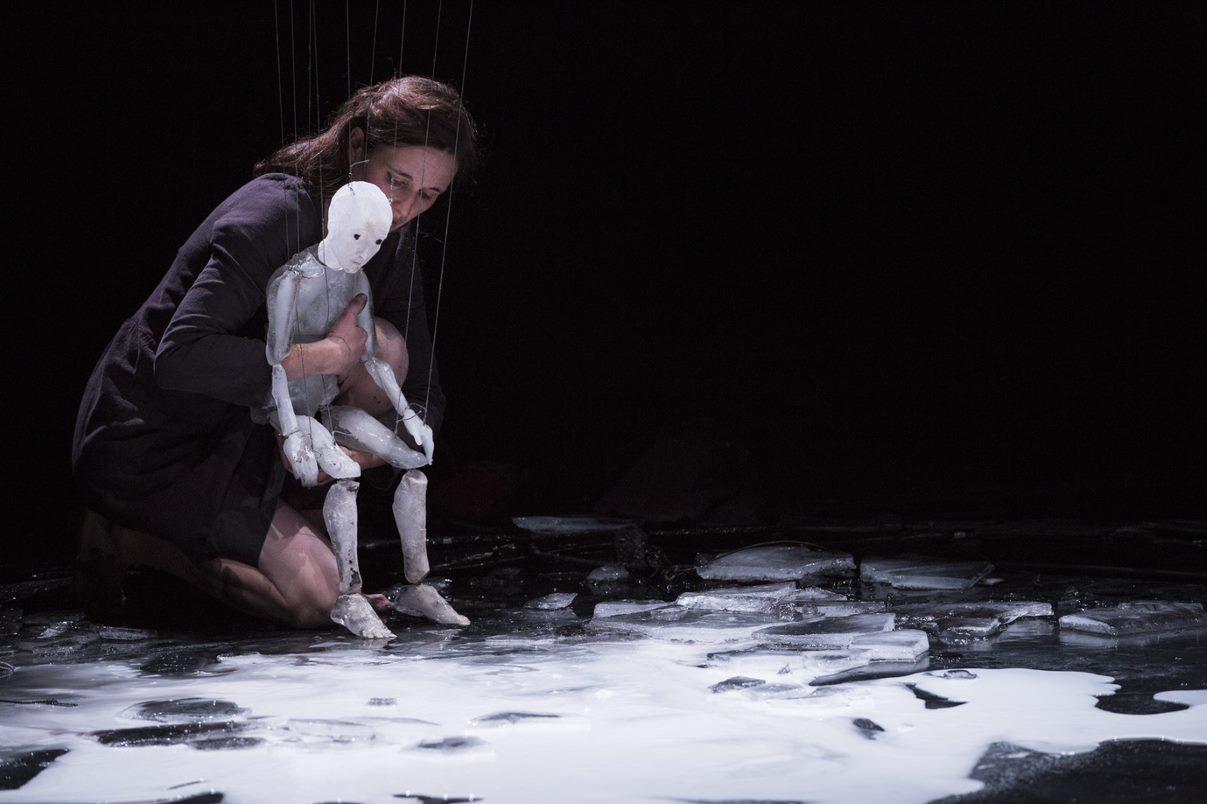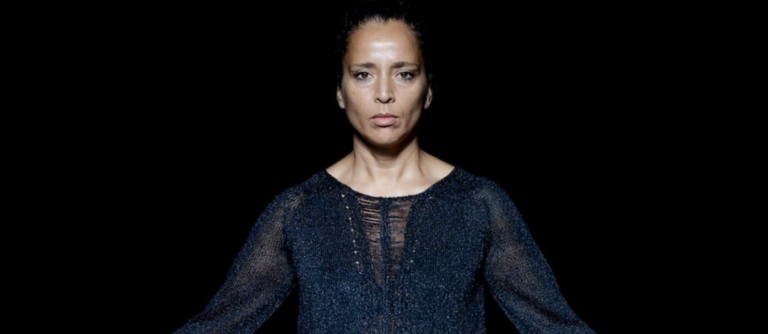
Interview with artist and puppeteer Elise Vigneron
Performance

©Vincent Beaume
The production ANYWHERE by Théâtre de l’Entrouvert-Elise Vigneron was recently been transmitted to an American cast of puppeteers. The American version will be presented at the Chicago Puppet Theater Festival in January 2023. Inspired by Oedipus story, the performance stages a puppet made of ice. Elise Vigneron, the creator, describes her approach and the transmission process to the American team.
The production ANYWHERE (2016) by Théâtre de l’Entrouvert – Elise Vigneron, an adaptation of Oedipus on the road by the Belgian writer Henry Bauchau focuses on the final journey of the hero. It invites the viewer to go through the different states of the water element, the inner metamorphosis of a mythical character through a string puppet made of ice conceived with puppeteer Helene Barreau.
Following the invitation by Blair Thomas, Founder of the Chicago International Puppet Theater festival, ANYWHERE has recently been transmitted to a cast of American puppeteers (Mark Blashford and Ashwaty Chennatt).
The U.S. premiere will be presented at the Festival on January 19-22, 2023
In the short interview below, Elise Vigneron speaks of her approach of the ice material and the processus of transmission of the work to an American team:
VA (Villa Albertine): Before all, what inspired you in Bauchau’s novel? What came first, the novel or the material made of ice – which melts to turn into water.
Elise: After the creation of the performance called Impermanence (January 2013) where I used ephemeral materials such as ice, I wanted to continue this exploration by staging a puppet made of ice.
This idea was prior to the text. Then I looked for a text that could back up the dramaturgy.
I was fascinated by the novel “Oedipe sur la route” (Oedipe on the road) by Bauchau, by his writing, his use of symbolism and poetry, and his relation to the subconscious.
This work seemed so powerful to me when I read it that I had the impression of staging it, but I also thought that giving it a shape might reduce its impact. However, it kept coming back to my mind.
When I shared with Benoit Vreux (the dramaturge of ANYWHERE who also knew well Henri Bauchau) my thoughts of giving shape to Oedipe’s spiritual metamorphosis with a puppet made of ice, I knew my intuition was right.
The performance was built by interlacing what the novel inspired me about installation, images, sounds, materials, and the manipulation of these materials, and recurrent topics in Bauchau’s work. All along the creative process, I looked for a streamlined form that remained open to the audience’s interpretation.
VA: Could you describe the different phases of the transmission of such a work – a new experience for you — and the intense interaction with the puppet, between Oedipe and Antigone, and the ice itself?
Elise: The project of transmission of ANYWHERE was born from my encounter with Blair Thomas, the founder and director of the Chicago International Puppet Theater Festival, himself a puppeteer. It happened when we were on tour in New York with this performance in March 2020, a tour that was interrupted by the pandemic. During the lockdown that followed, we kept a correspondence on topics related to puppetry, our inspirations, our relation to the materials, our questioning about this world in a shambles, and to our desire to re-imagine the circulation of our work to reach out international audiences. During that moment when we stopped our activities, re-thinking of new ways to re-define our lives – what we do, our jobs as puppetteers – was very meaningful.
And this is how we started to think of the transmission of ANYWHERE. First, we had no method, only the desire to think about new ways of cooperation and to build a strong artistic adventure together.
Then followed many conversations between our teams to shape and structure the project. I found collaboration very strong right at the beginning because everyone could participate and invest in the construction of the project, taking some initiatives.
Blair selected a team of American performers (the puppeteers Mark Blashford and Ashwaty Chennatt) and technicians and Théâtre de l’Entrouvert took responsibility to re-construct the set and the puppets.
This project was possible thanks to the support of FACE Foundation – Villa Albertine, Institut français as part of the program EXPORT as well as the AVIAMA (International Association of Puppets Friendly Cities) and private support.
The two teams met last December in France during the presentation of ANYWHERE; it was the opportunity for them to attend several performances at Le Cratère, Alès, and to start working. It was intense and it gave us the feeling of a new momentum for this performance that has already been touring for six years.
The show ANYWHERE is not transmissible as a finished object. It requires the team to adapt itself to the unpredictability of the materials at stake. In transmitting the work, and beyond the realization itself, it is an original approach based on research and experiment that we share together. This is that specific path that interests me.
In addition, to work with another team, another culture, brings us to re-create the performance, to be “in the moment” and that is very exciting. The American team has other methods of working once on the stage, of apprehending the text; for example, they are very organized and very efficient in their preparation of acting, they are also more expressive. Perhaps it is due to the acting of Ashwaty Chennatt – the actress performing Antigone — who is also an Indian dancer.
The interaction is at the heart of ANYWHERE: interaction between two teams of a different culture, interaction between the puppet (Oedipus) and an actress (Antigone), the constant interaction with the ice. By working, manipulating the ice – a precarious, unpredictable, material – you always have to be on balance. You keep on adapting yourself to the material, to the substance, and it leads us to new experiments.
Nowadays, in a world where we face our own vulnerability, this material, the ice, puts us in the cyclic time of transformation. The substance and its characteristics immediately provoke empathy from the audience; it connects us with our own substance as well as the world we inhabit. It speaks directly of our ever changing world.
VA: Your next work is also inspired by a literature masterpiece The Waves by Virginia Woolf where the element of water is also prominent.Tell us more…
Elise: Yes, I am currently involved in the creation of a performance for several human-size puppets made of ice. It will premiere in Marseille in October 2023.
We adapted the novel The Waves by Virginia Woolf but we kept the central structure, the life trajectory of the five characters from their childhood to elderliness.The construction of their identity and their progression in life are put in parallel with the description of the sea, from the dawn to the twilight.
Through these ice puppets, “time beings” that melt to merge in the Waves, I am interested in the links between individual, collective and “cosmic” identity.
It is a very exciting project for me. It gives me the opportunity for a deeper exploration of the ice by working with la glace creuse – i.e. when a body, a volume made of ice has been emptied of its water revealing the outline, the contour in ice – as well as techniques of glaciation and manipulation at a much bigger scale.
Between theater, puppetry and dance, the different characters multiply, from 5 to 10, with the presence of actors-manipulators to create an ensemble, a choir to the image of our world. To dialogue with this magnificent text also gives me the opportunity to explore the rich and intimate world of Virginia Woolf.
In partnership with

FACE Foundation
FACE Foundation is an American nonprofit organization dedicated to supporting French-American relations through innovative cultural and educational projects. In partnership with the Cultural Services of the French Embassy in the United States, FACE Foundation promotes artistic, literary, and educational exchange and collaboration between creative professionals from both countries. With additional corporate, foundation, and individual support, FACE Foundation administers grant programs in the performing and visual arts, cinema, translation, and secondary and higher education, while providing financial sponsorship to French-American festivals and other cultural initiatives. FACE Foundation focuses on new and recent work of living artists and the promotion of bilingualism and the French language.


